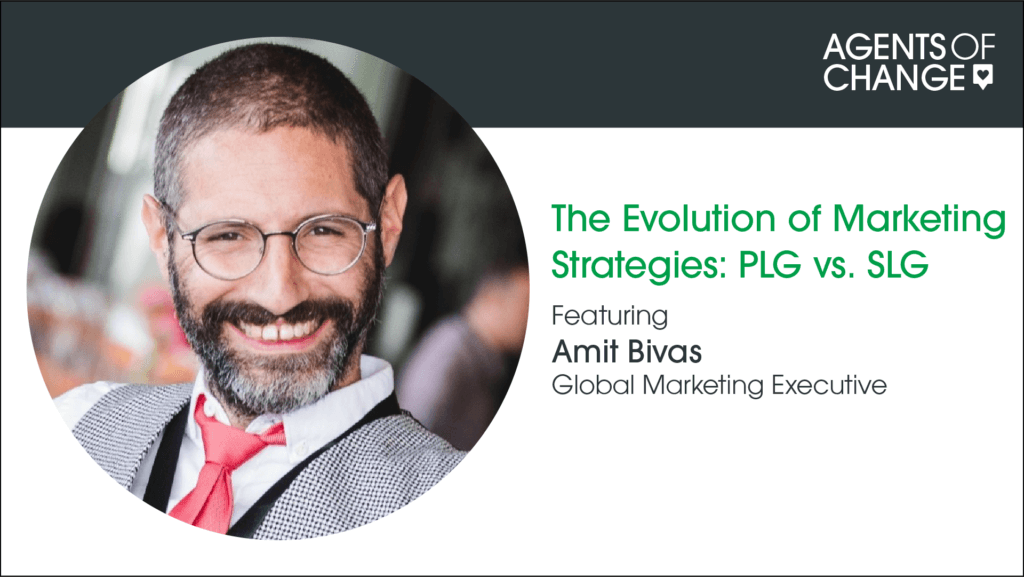Product led growth (PLG) has recently gained substantial traction in the business world. While traditional sales and marketing strategies revolve around growth via lead generation and sales conversions, PLG introduces a slightly different approach.
In this episode of Agents of Change, host Danielle O’Neil delves into PLG in a conversation with Amit Bivas, a seasoned expert in the field. Amit provided some insightful perspectives from his experience with this innovative model.
The Rise of Product Led Growth
Product led growth is a novel approach to customer and revenue growth. Amit highlights that this model is relatively new in the B2B space. “The common practice is sales, growth, and marketing that generates leads that become sales. But product lead growth is new to B2B marketing,” he says.
So, how does product led growth differ from the traditional model? In the traditional model, the emphasis is mainly on lead generation and converting those leads into sales.
Product led growth takes a different approach. Amit calls it the “no-touch approach.”
“Product led growth is— you can think about it as no-touch. There’s no human being there. The prospect or the subject of the marketing is working with the website, and they don’t need to meet an actual person at any point.”
In this model, the product is the primary customer acquisition driver. The focus is on creating such a valuable and user-friendly product that users want to adopt it, often through viral means or word-of-mouth.
This “no-touch” approach is the essence of PLG. It emphasizes the importance of the product itself in driving growth, reducing the need for direct human intervention in the sales process.
Speed and Efficiency
As Amit points out, one of the most defining features of PLG is its speed. “In product led growth, things move very fast,” he says. “It’s kind of an automated machine. In sales led growth, usually the time periods are longer, right? Because there’s a human in the middle.”
The automated nature of PLG can lead to faster results. Since there isn’t a need for back-and-forth human interactions, processes can be streamlined and optimized more quickly.
PLG also maximizes the efficiency of the sales process. It allows “self-serve” customers to experience the product and make a buying decision on their own as they move through the customer journey. That frees up sales resources to focus on accounts that require a more hands-on approach.
Evolving Buyer Preferences
Customers enjoy the PLG experience. In fact, Amit says, a significant shift in buyer behavior is driving the adoption of PLG. “This kind of new buyer or new user doesn’t want to speak with [a salesperson]. They want to rethink.”
These buyers don’t want a cookie-cutter experience where they are given a tour of the features a salesperson thinks are the most relevant. They want to poke around, explore the product for themselves, and discover how it fits into their workflows.
There’s a renewed emphasis on rethinking and self-exploration by users. And businesses need to adapt to the changing preferences of their customers.
PLG vs. Traditional Marketing
Marketers who want to implement PLG shouldn’t necessarily jump into the deep end of the pool right away. There are nuances to the approach that are important to understand. Amit learned about the model by working with experts.
“I worked very closely with the folks [doing] PLG,” he says. “I have seen it—how it works, and kind of the similarities and differences [to the traditional model].”
While he worked primarily in the B2B enterprise marketing space, Amit’s collaboration with PLG professionals gave him a comprehensive view of the advantages and challenges that the model presents.
It also reminded him that no single approach is foolproof. Product led growth is an excellent approach, even for B2B products. But it probably works best when it’s practiced alongside other methods like sales led growth, traditional marketing, and other tactics. It’s not an “either/or” as much as it is a “both/and.”
The PLG model represents a seismic shift in how businesses think about growth. Its emphasis on product value, combined with the evolving preferences of modern buyers, makes it a formidable force in the market.
When executed well, PLG can offer unprecedented growth opportunities for businesses.
Ready to get started with B2B social media? Let’s talk!
